https://www.youtube.com/watch?v=kPPglLjQPdk
How to Draw a Leopard [Narrated, Step by Step]
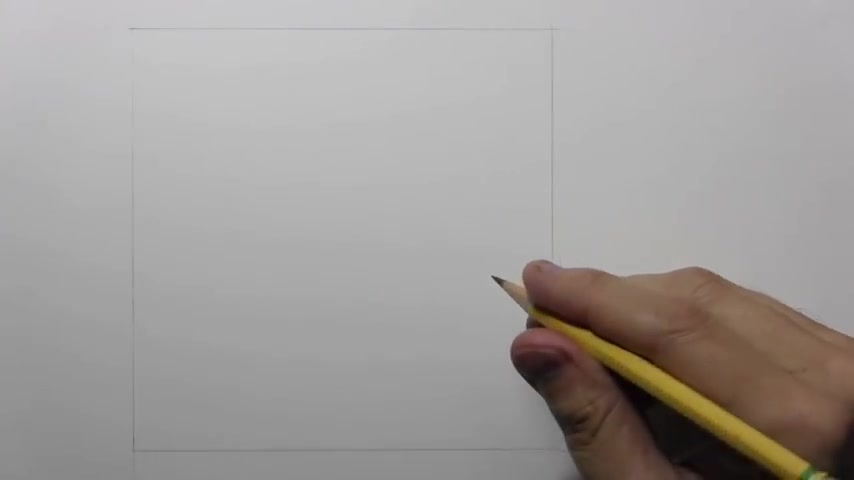
Hey there everybody .
It's Mark Crowley .
I'm back with another how to draw a video .
This is number 10 in an ongoing series of videos on how to draw animals .
Uh I've had a video on how to draw a wolf , how to draw a kitten , how to draw fish .
And today I'm gonna be showing you how to draw a leopard .
Now , what we have here is a perfect square .
It is uh around four and three quarters inches on all sides that comes out to uh almost exactly 12 centimeters .
So once you've got that square in place , what you want to do is place a dividing line here vertically uh exactly in the middle .
OK .
So I'm gonna add just two lines here , just very slightly diagonal lines that are gonna divide this square roughly into thirds and one will help me for placing the eyes the other for placing the nose .
OK .
Now , this video is a little different from some of the other ones I've done very often .
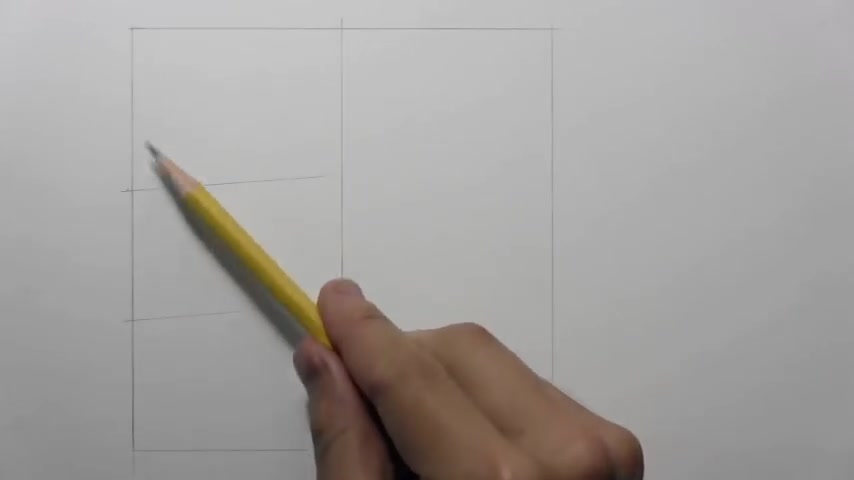
I've just had the face looking straight at us .
Uh So it's perfectly symmetrical .
This time , I'm gonna have the uh leopard facing off in a sort of a three quarter point of view .
So let's begin by working on the contour of the leopard's face .
OK .
So you can see it's just sort of a curving line that starts right up here comes across and uh it almost meets where that line um intersects here .
It actually just sort of crosses past and then , uh touches the left hand uh edge of the square right around there and then curves back a little .
Now , I wanna draw the uh nose .
I'm gonna begin by putting a triangle right around here .
OK .
So you can see I've made just a very uh kind of exaggerated triangle here .
We'll be refining that later into the more uh accurate drawing of the nose .
But uh pay attention to how it doesn't quite uh touch that left line .
Uh and then sort of has a diagonal slope coming up the , the snout .
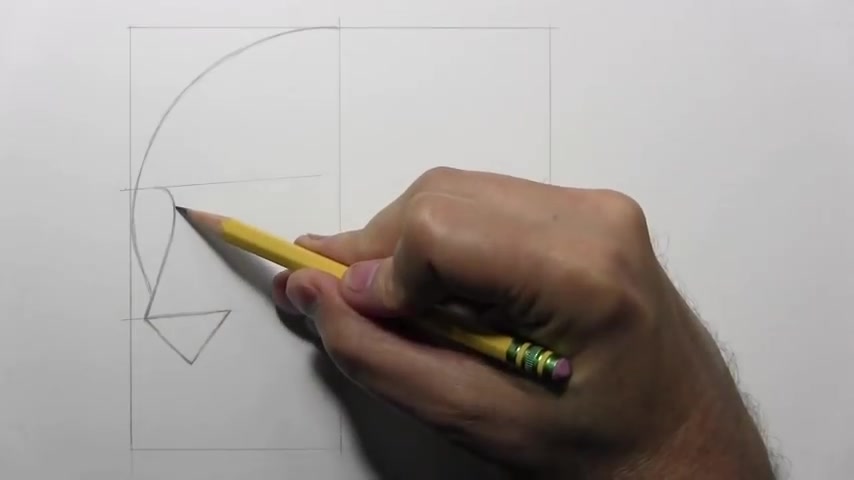
What do I , I always call it the snout of the region as it begins to uh curve into a line for the eye .
And so , you know , speaking of the eye , let's go ahead and draw both of the eyes right now .
So notice um two things about the eyes .
One is that there are different shapes .
This one is uh really more of just an oval like shape .
Uh And this one has more of a teardrop uh shape coming to a point .
Uh It really has to do with the point of view of the angle that we're looking uh at the animal from .
And uh now I think it's time to go ahead and finish off drawing the um uh the mouth and the jaw .
Ok .
So you can see how I started at the point of the nose curving down here .
This line sort of echoes this line up here that might help you for getting the angle right , uh conveniently goes very straight across the bottom uh of the jaw right along that original line and then just comes and barely crosses over that uh center line .
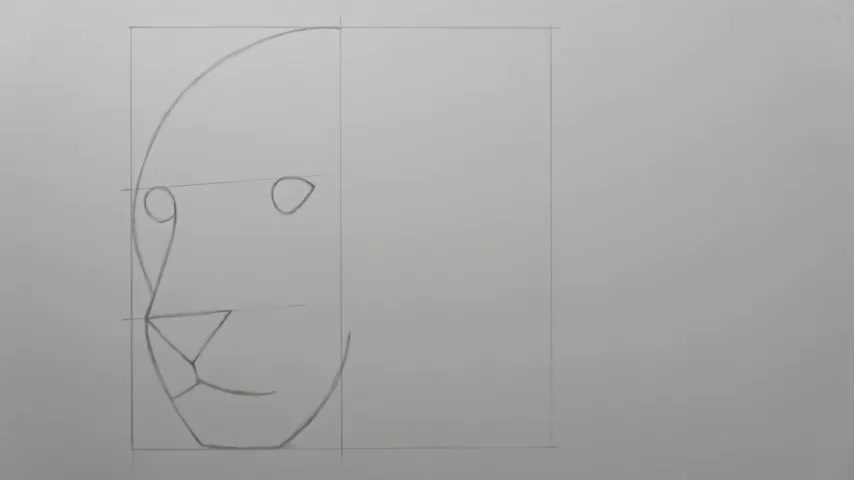
Then of course , you have the left upper lip and notice that the mouth is considerably closer to the nose uh than it is to the jaw .
Well , let's go ahead and place the ears , all right .
So I decided to go ahead and finish off the shape of the head .
But uh first of the ears notice this one sort of triangular in shape , nearly touching that upper line , this one at a , you know , we're seeing it from a different angle , it's crossing over that upper line and uh considerably less uh triangular looking .
One thing I noticed as I studied photos was uh this sort of interesting shape here over on the back of the head as it curves or sort of has an indentation , uh and then comes down here and flattens out very much uh like the jaw right there .
Well , I think it's almost time to stop with the time lapse .
So I'm gonna do just a couple of more lines , uh , around the eyes , uh , maybe get a dividing line here across the forehead and then finish off the neck .
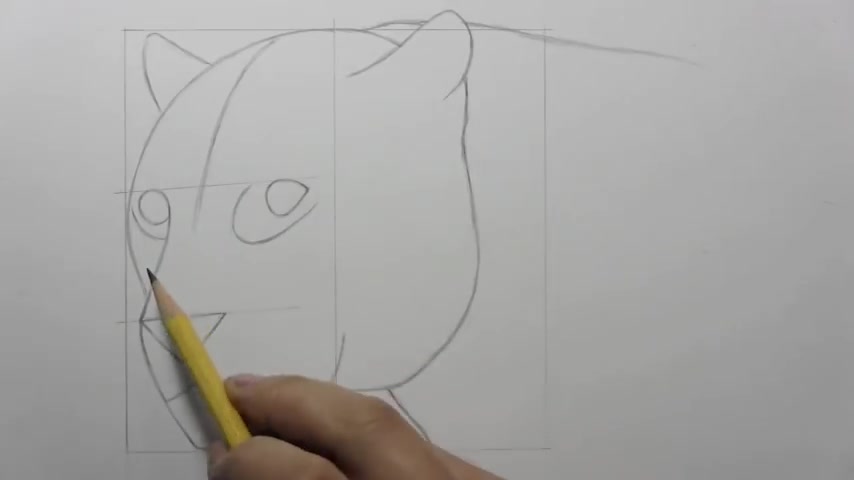
All right .
Well , this line here is gonna help me get in a sort of area of white , uh , that I observed in on some leopard's eyes .
And , uh , this , there's not actually a line going down the middle , but it'll help me sort of organize the spot uh later on and uh notice how strong the neck is , you know , comes way up high .
Uh , and uh getting that distance there will uh help you , um , get that final line in there .
And I think now we can finally uh knock it off with the time lapse , we can tell old man time lapse to go get a cup of coffee .
Oh , I could really use a cup of Joe right about now .
Uh And that means that we can uh do some real time drawing .
I'm gonna zoom in here and uh we'll start working on adding details to the eyes .
Ok .
So let's begin by uh adding the pupils , uh which uh are gonna be uh what's the opposite of dilated , undilated , anti dilated ?
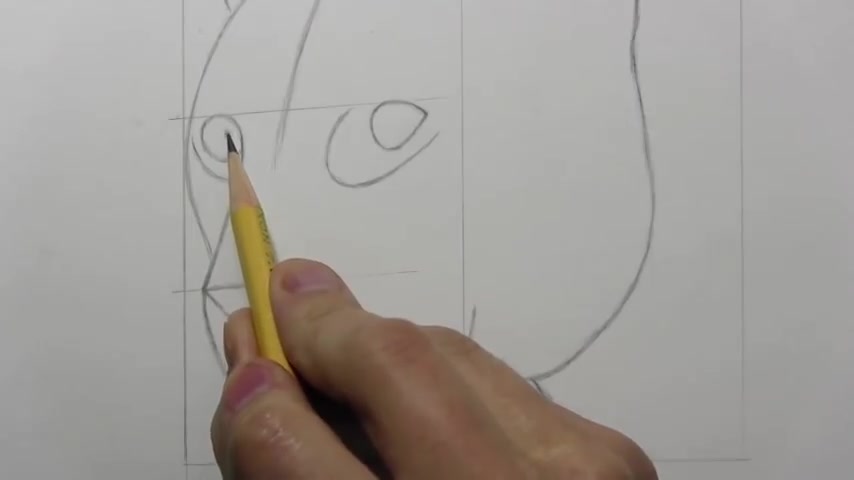
They're gonna be quite small , I believe uh in the daylight , uh they , uh you know , the pupils would get quite uh tiny so as to not allow too much um , sunlight , blinding glare of the sun into the eyes .
Uh notice the placement here , this uh in the three quarter point of view , this pupil is considering considerably to the right uh over here , uh a little more dead center , at least in the photos that I looked at .
Um maybe a touch closer to the top , but uh side to side , uh not so exaggeratedly off to one side as it is um on that other eye .
And uh what we wanna do now is get in um a an area of black , a shape of blackness that goes right around uh the edge of this , uh as I said , sort of teardrop shaped eye .
Um And the this area of blackness kind of comes off to one side a bit like this .
You can see me sort of uh having it uh extend to me .
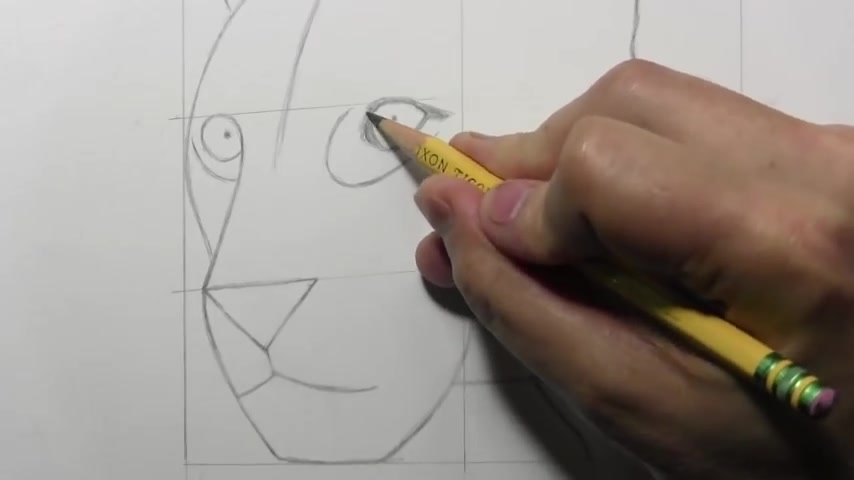
It reminds me a little bit of like the uh the Egyptian pharaoh uh illustrations uh with that heavy kind of uh eyeliner kind of a look .
Uh But then coming around here , uh uh from this point of view anyway , uh it's , it's quite thin as it comes across and then it , it thickens up around uh the area of the tear duct , at least for human beings , it's the tear duct .
Not sure if that's the right terminology , you know , me , I never know any terminology for anything , but there's quite a huge um uh extended black area right here again , kind of protruding off of uh the tear duct , the tear duct to the region .
I'll just invent my own words , why not ?
I have a long grand tradition when you don't know the word , just invent one that doesn't exist .
So , uh this shape here , uh it is really quite pronounced .
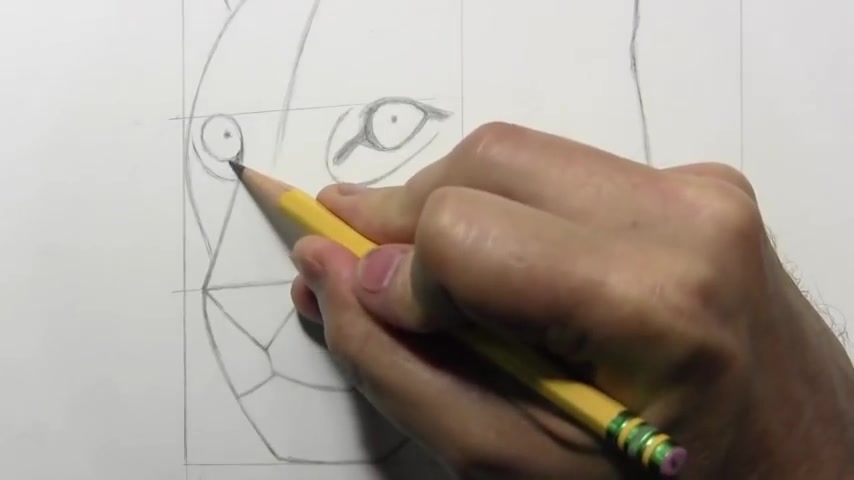
I noticed as I studied um photographs .
Uh and um you're not gonna see it so clear clearly on this side from this uh three quarter point of view , but you are gonna get a pretty strong indication , uh , of it as it curves around the , uh , the bridge of the nose .
And so let's go ahead and darken in all around here .
Now , I can tell you right now there's gonna have to be , um , you know , time lapse of plenty later on in this video .
You can see how long it's taken me , uh , just to do the eyes .
I can't , if , if I spend this much time on every single part of the , uh , uh , face and fur , we'll have a three hour long video and , uh , I just can't do that .
Um , but while we're over here , I do want to point out something this curved line of the forehead is , um , a little bit of an exaggeration , uh , in terms of , uh , the actual structure of the forehead .

So , what I'm gonna do right now is sort of erase away a little bit and show you how I would refine this a bit , um , with , um , sort of like a , the brow .
Um , just above the eyes , maybe some indication of the uh skull underneath there .
So you can see how it sort of dips in and then comes up here to where the uh uh the ear is and then uh maybe just a slight angle uh as it comes across and rejoined that line .
So , yeah , sort of refining that contour there .
I'm gonna just go ahead and get rid of that .
Well , apologies there , folks .
Sometimes I just forget the focus of the camera and so you probably were not able to see the upper extensions of that line there .
But uh here you go , having refocused the camera for national Refocus the Camera day , you can now see what I did there uh in its entirety and uh we might as well go ahead and uh get an extra line here for the ear .

So you can see just maybe a hint of the upper edge of the ear , uh And then over here as well , um maybe just get the edge of the ear in place .
It's gonna be , there's gonna be a lot of fur um across this ear section .
Although I think I might uh sort of get a little indication of uh structure here where the ear joins the head .
But yeah , it does get , it all is gonna end up getting quite obscured by Tufts of fur that come out of the ear .
I've noticed that with cats um that there's uh almost always quite a bit of uh fur inside the interior of the ear , something I'd never really noticed until I started studying uh photos of cats .
And indeed , the structure of the face of a leopard is surprisingly close to that of uh of , of an actual house cat .
Um But I feel like I may have missed something here in terms of the eyes .

Uh Yeah , I guess uh what I wanna do is sort of uh erase away here and um show how the , the purpose of that line really is just to give us a uh a sense of where uh a white area forms near uh the eyes , at least uh on some breeds of leopard .
And uh so that's what that's all about .
There's not really a hard uh dark line there .
It's more just uh that sort of delineating an area of whiteness and uh probably toward the end of the video , I'm gonna put out my old beloved white gosh and uh really uh lighten that up quite a bit .
I feel like this top area here could be thinned out even more .
Get that shape , right ?
And so over here as well , this is really just a delineation of uh of a whiteish area .
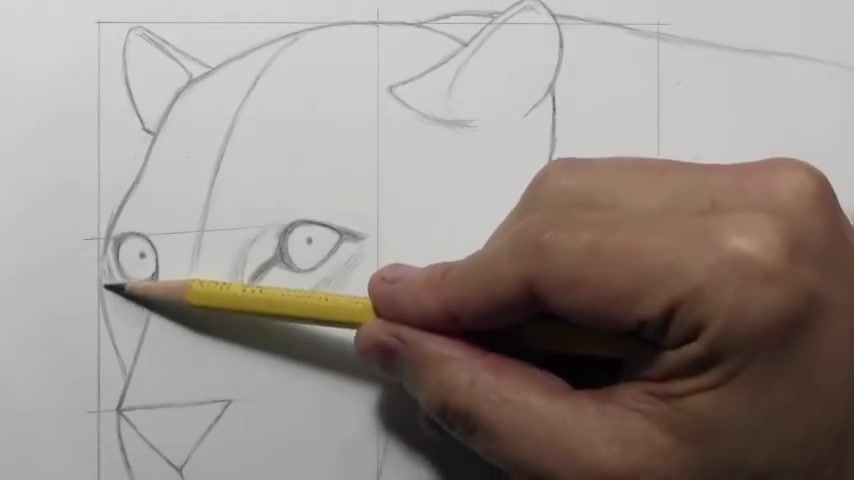
And maybe now let's , I'm gonna to refocus the camera so that we can start working on drawing the details of the nose .
All right .
So as I said , uh earlier , this uh triangle is really rather exaggerated , but it helps you sort of place the lines and we can sort of refine them into something that's , um , a bit more anatomically accurate .
Uh , one thing that , uh , I've noticed is that , uh , a lot of , um , animals , not just , um , I think the wolf had this as well .
Oh , I'm sorry if I'm misremembering .
But , uh , you know , you have the nostril over here , uh , but there's this area off to the side that uh curves up like some and it's quite pronounced , um especially from this point of view , this three quarter point of view , um this sort of extra area in here , this all gets sort of blackened in .
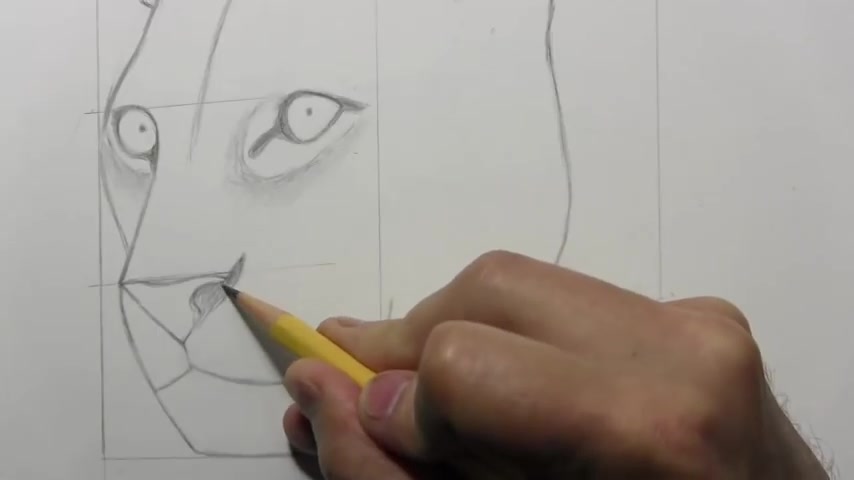
But uh I believe someone in the comment section on one of my videos said that helps for pulling in scents from the side , you know , that uh having nostril , uh having the shape of the nostril helps for pulling in , you know , the sense of smell is I'm sure key for the Vival of the start acting like I'm some kind of expert uh in any case .
Uh Yeah , getting in that .
Um uh This is something that I think you don't notice too much when you just sort of draw a leopard from your imagination , uh that extra contour .
Now let's go ahead and get a uh a central line that divides the uh nose and two , of course , from the three point of three quarter point of view , you're gonna see more uh considerably more of the nose on this side than on the other .
Uh In fact , I think I'm gonna widen out this nostril and make it a little larger .

Uh And yeah , because he's in a three quarter point of view , we're not gonna see that other nostril really at all , but we can by way of the contour suggest uh its presence by sort of carving away a little area here .
Now , I was surprised as I studied photographs how much this triangular area really does come down to a point where you know what I was calling the sort of cleft upper lip , uh this area of darkness joins in in a pretty bold way .
In fact , you can kind of take this whole area here and turn it into a single uh area of darkness that uh comes right down like so and then splits in two .
Now I'm gonna go ahead and darken in , you know , the , the mouth is not open , but you can kind of see in there a little bit from this point of view , the far edge .
So that allows me to sort of refine this contour , just a touch .
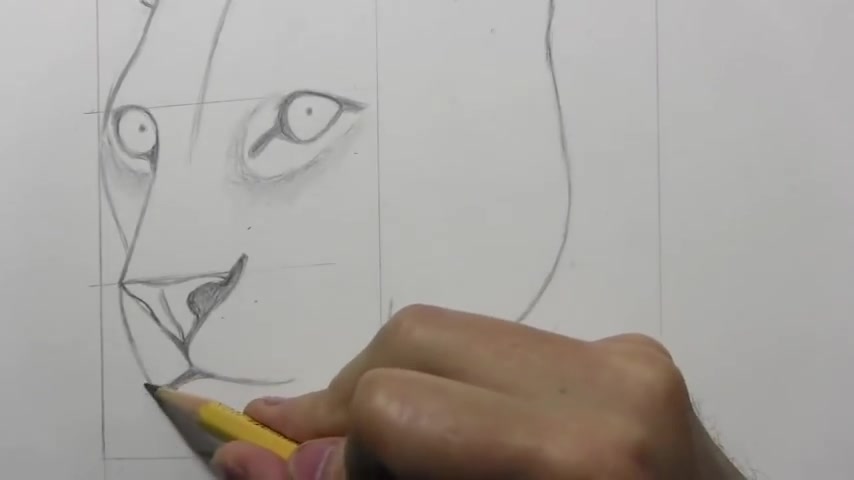
And um it's probably a little early to start getting into matters of the fur , but rest assured later on , I'm gonna be devoting some of the video to , to talking about the fur and in particular the direction that it all heads in .
Oh , here's an area down here .
Yeah , I'm still in frame .
Now , I'm paranoid that I'm gonna be teaching you all the stuff that you can't see because it's out of frame .
Uh I noticed in a variety of different photographs .
So I have to assume that this is common among leopards , this area of darkness down here .
I'm gonna start to delineate it right .
Uh Coming down to the edge of the uh the , the lower jaw , I guess .
And then all in here , this whole area right here on , um , at least a number of breeds uh of uh leopard is quite dark , uh and showing up almost just as jet black in a lot of photographs .
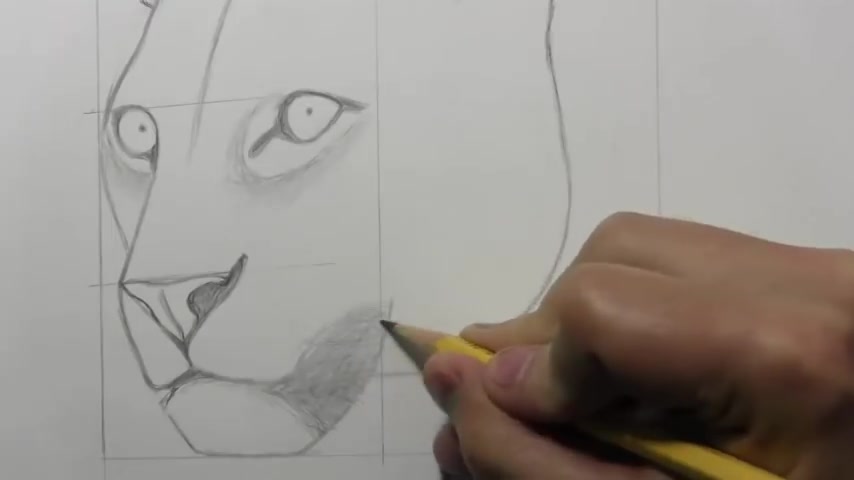
It's a , it's an area covered with fur but uh covered with black fur evidently because you just don't see much detail down there at all .
But I had never again , I never really noticed this until I started studying .
Um , and , you know , later I'm gonna pull out my black uh prism of color and , and really go to town darkening in this area .
And yeah , I'm not real clear on the definition , uh how uh what the shape of this black area is , but I didn't know , did notice it extended quite , quite a bit through this whole region here .
I think maybe it does sort of come to an end like that and now it's time I think to start getting in these , the sort of rows of , of black dots .
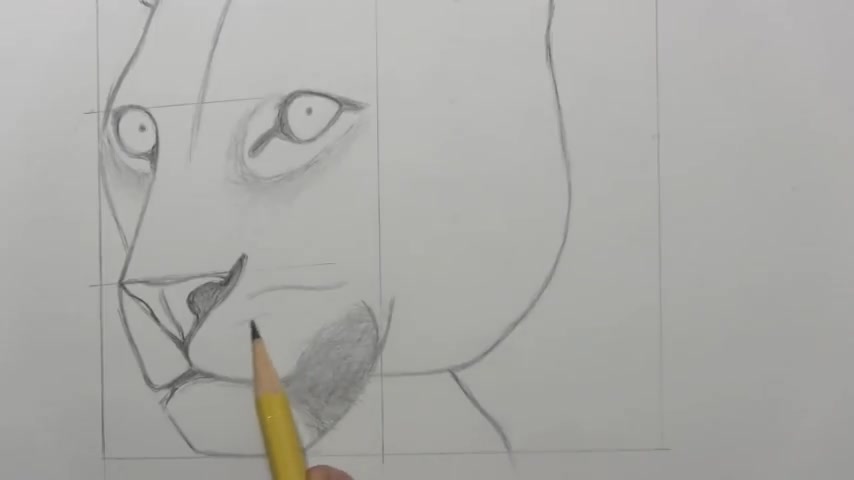
Um I noticed that there were three that were quite um pronounced and they have a uh very slightly s shaped um sort of line structure here .
Now , this is not , it looks like I'm drawing whiskers on him .
That's not the case .
This is uh going to be turned into a series of black dots that it seems to me are related to the uh to the whiskers where they emanate from this snout region .
So these three uh lines are gonna help me figure out where to put these dots .
Now they get quite big .
Well , I'll just start in the middle one here to show you what , what I noticed from photographs .
Again , quite , quite big , bold uh black dots .
I think this is different from some of the other uh animals that I've drawn , how , how bold these areas are .
In fact , the dots sort of touch one another .
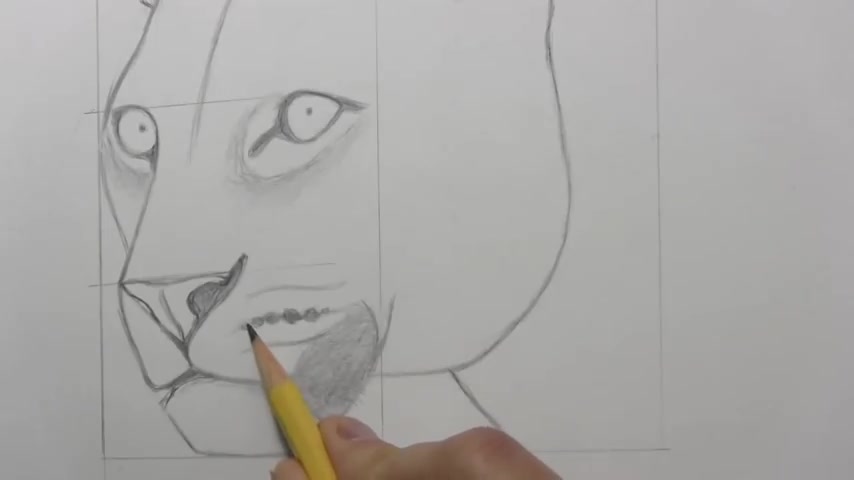
So it almost you feel kind of like you're drawing a sort of caterpillar like shape in here .
Um Again , you know , there's some , there's probably different breeds of um leopard and this does not necessarily apply to all of them .
But uh it did seem to be a um a noticeable characteristic from my point of view , something worth paying attention to as you as you draw .
So you can see me adding in that um again , nearly touching sort of blending into one another .
Uh these different areas .
I did notice a secondary uh region of um of dots just a little closer to the actual nose itself and these ones seemed more , uh , separated .
And over here the whole thing is curving away from you from the three quarter point of view .
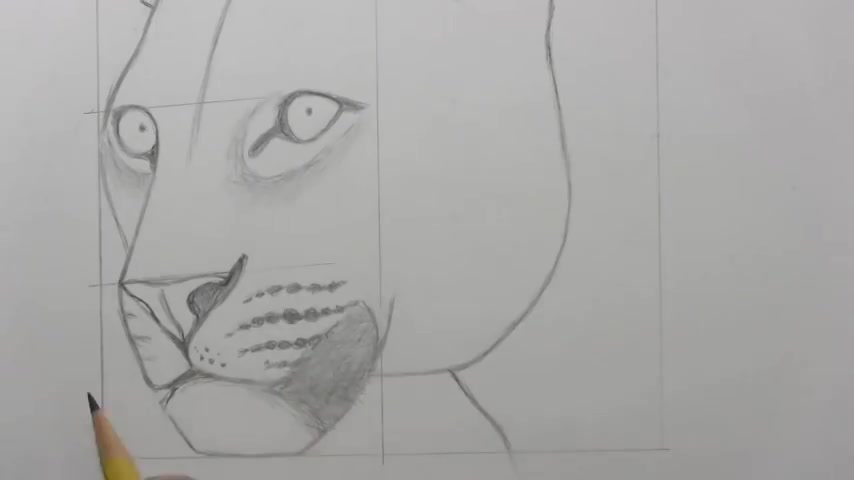
So you're just gonna sort of suggest maybe as I said , there's , there's , there's sort of like these three dominant rows , but I think there is sort of the suggestion of , uh , of , you know , sort of secondary rows down here .
But yeah , over here , you can't really see them so clearly they're just sort of curving around .
And I do wanna get the , the similar sort of freely spaced dots that correspond over there .
So many details , so many details to pay attention to .
Oh and then also um this area of the nose probably uh needs a little shading in .
So we get that in place .
And I noticed again , at least in some photographs , a um a bit of speckling uh occurring little dots here and there on the nose and just fairly randomly placed , I didn't perceive any pattern to speak of .
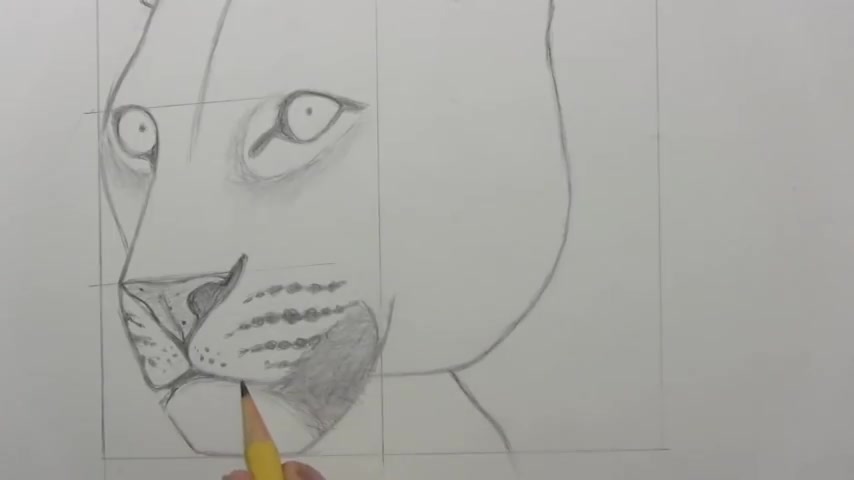
Now , down here , beneath the , the upper lip is uh AAA shaded area that I think is really actually the flesh , the lower lip which becomes a little bit visible , at least in some photographs , but it is fairly hidden in shadow .
And down here is where um I saw sort of splotchy areas of black and he , he does have sort of like white facial hair .
It almost looks would remind us of a beard um that uh increasingly gets thick at the very bottom .
In fact , maybe now it's time to start talking a little bit about the direction of the fur .
So I'm gonna start doing that .
I'll go ahead and plunge into uh drawing the details of the fur coming out uh to , you know , the left and then uh sort of all along this edge .

Uh I'm seeing the hair uh uh coming down almost like the um like a clock face , you know , as it curves around here .
Now this is white hair , that's what makes it a little tricky to uh to draw it because you're , you know , I'm using this sort of the gray of a pencil actually to suggest the contours of what are uh white hairs .
And so , yeah , you're sort of faced with without having a dark background to show this against .
How do you uh suggest the presence of white hairs ?
Well , I'm sort of cheating , I guess is what I'm doing .
I'm sort of using the , the grade and to help convey that um contour line of the face , but then also erasing away here and there .
So as to not have it look too dark anyway , we're gonna keep working on that uh as time goes on .
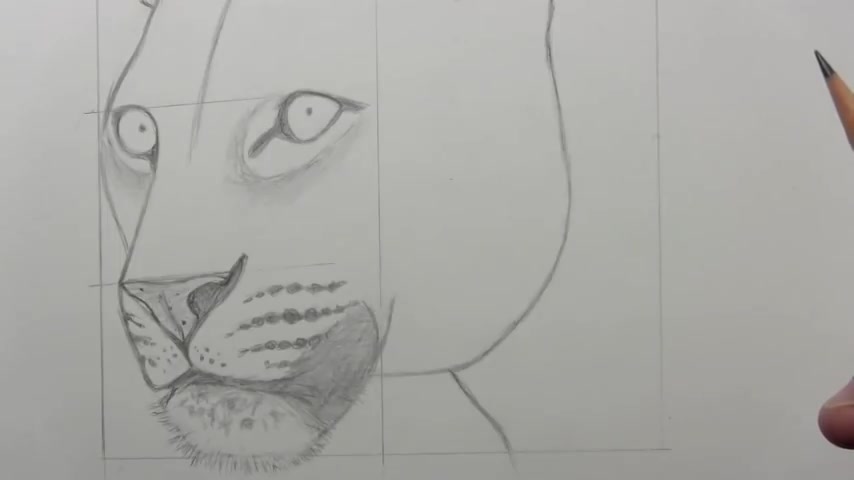
But I wanted to talk a little bit about the um the direction of the fur all across the face .
Um And again , like I said , I can't really do all of this in real time , but I'll give you just maybe a few pointers um uh in various regions .
Like right here , I noticed uh in photographs coming off of the eye , uh that uh the fur was sort of um extending again sort of clock face style across uh this area of the eye and then it begins to curve up .
Now , all of these hairs are quite short .
I'm gonna go ahead and erase that initial guideline while I'm at it here , all of these hairs quite short as they uh go all across the face .
This in contrast to a number of the other animals that I have drawn .
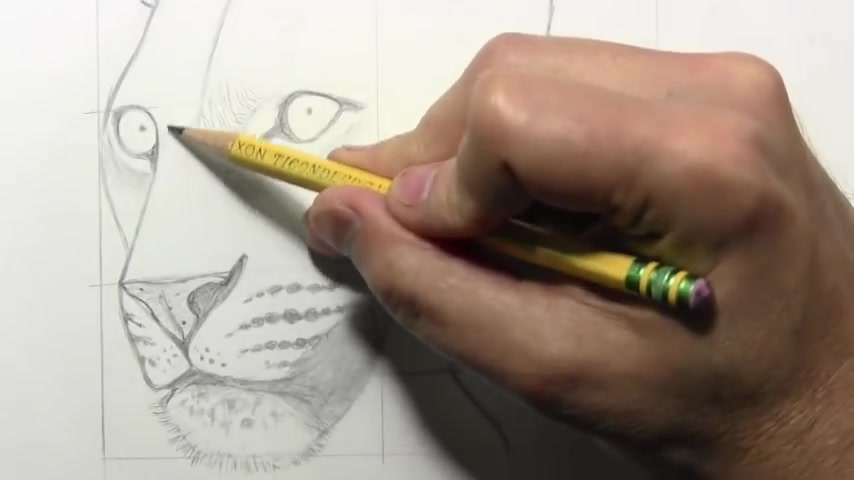
Uh It seems that other animals there are the uh area of the snout uh is the hair is very short , but then those hairs will get increasingly long on other breeds of animals I've uh saw in as I studied these photos that the hair remains quite short all across the entire face uh of the uh leopard .
And that uh I think is in contrast to to many of these other animals , but you can see that I'm paying attention even as I draw these tiny little lines uh to the direction that they're pointing in uh in this area , mainly pointing upwards .
Um But then like I was saying this coming across here , it seemed that they begin to actually point down and and across the snout area here , they get very short .
Indeed .
And uh sadly , this is just gonna have to be an area that I refine uh in time lapse .

It's just , you can see it just becomes , uh almost way too time consuming to , to do all real time uh in video form .
But I wanted you to get a sense of the direction that things are pointing in .
I mean , it occurred to me , uh again as I studied these photographs that the hair is almost like aerodynamic , you know , you would imagine with the , with the , the way they make cars these days , making them aerodynamic , paying attention to the wind blowing across the car .
It seems to me that the hair is on a leopard's face , our sort of aerodynamic pointing back across the sort of cheek area here .
So , um yeah , this is uh maybe gives you hopefully enough information about the direction that all these lines point in and all across there , you know , sort of uh maybe pointing up diagonally as you get into this area .
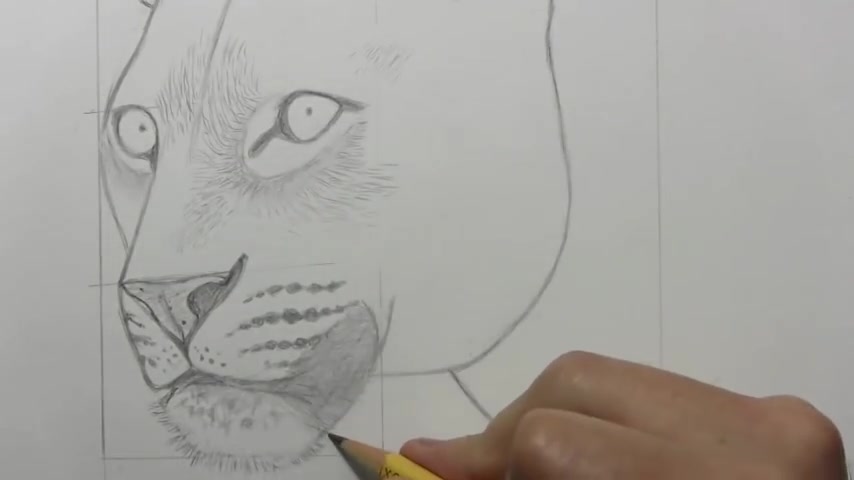
All of this stuff I'm gonna have to do later on , sadly , and uh that kind of brings me to the end of that part of uh you know , the facial features .
I want to now start paying attention to the spots .
That was part of my , you know , what attracted me to the idea of doing a leopard video was uh uh figuring out the the leopard spot .
So let's sort of refocus the camera .
So we can see the entire face .
OK .
So the pattern of a leopard spots , um I'm sure it's different .
Uh you know , each individual leopard is gonna have its own pattern .
Uh And indeed , it's not a super clear pattern on any of them .
It's uh there's a sort of a random like nature , but I did notice that there's this central area across the forehead and that's why I put that line in there .
And so I'm gonna begin in a fairly impressionistic way to just uh put um a sort of blur of spots almost coming down uh across the face following that line .

Now , as you draw the leopard spots , I think you have the opportunity to , to convey some sense of the form of the head .
Now , I'm not paying too much attention to the uh the direction of the hairs uh at this stage , but I probably will be later on when I go back in with the uh black prisma color .
But uh anyway , I wanted to point out how , you know , I'm making these narrow spots as the head curves away from view .
Uh And uh as we come down , you know , across the forehead so that uh it's more uh facing towards the viewer , uh these spots become more spot like they , they're not .
So they're not these narrow strips that you see up here , you're gonna see them uh from a little more of a dead on point of view in terms of the shape of the individual spots .
I would , I noticed that uh not very many of them are a perfect circle .
So I would say stay away from that .
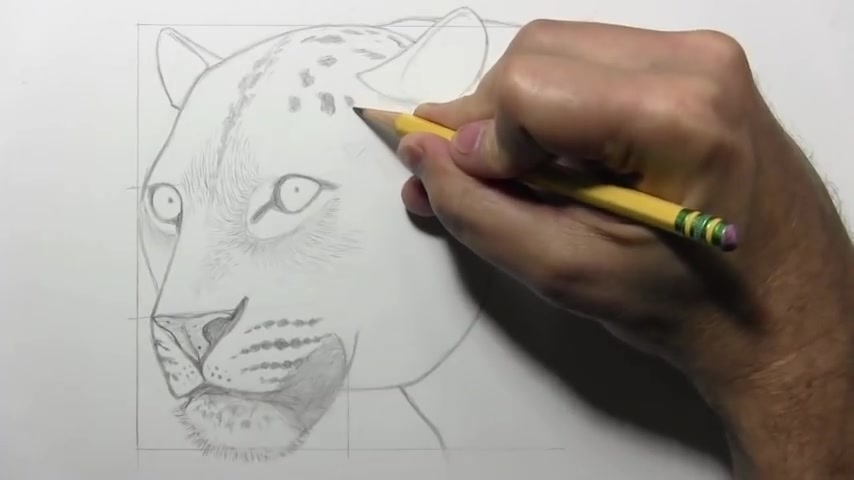
Uh you know , uh just sort of uh make them unusually shaped .
I think you can feel a certain freedom to , to play around with different shapes , the spacing of them .
Like I said , I did not perceive any super regular uh pattern in terms of the placement of the spots .
Um But I did notice that like over here on some breeds , you would see a sort of cluster of darker areas , sort of like a cluster of spots almost rising up from um that kind of inside corner of the eye and uh maybe across here , at least to one of them um leopards uh that I looked at , you know , one of the photos that I studied had a what seemed to be a little bit of a , a streak of spots that uh framed one side of the eye .

But I would say mainly in terms of uh drawing the spots paying attention to um you know , the angle of the head , especially if you're gonna do a three quarter point of view , you don't want a round spot like this right there .
No , because he's facing away from you .
It's always going to be uh a little more of like a side view of each one of the individual spots .
And so , you know , the more you um pay attention to that .
I think you will be uh rewarded with um a very three dimensional look towards the end of your drawing , even like a spot that's curving a little bit , you know , uh suggesting the , the um structure of the uh the bone structure underneath .
And there probably is a , a roughly symmetrical , you know , if you've got like a , a , a cluster of spots right here , you're probably also gonna have some sort of uh roughly similar cluster over here .
And let's see what else ?
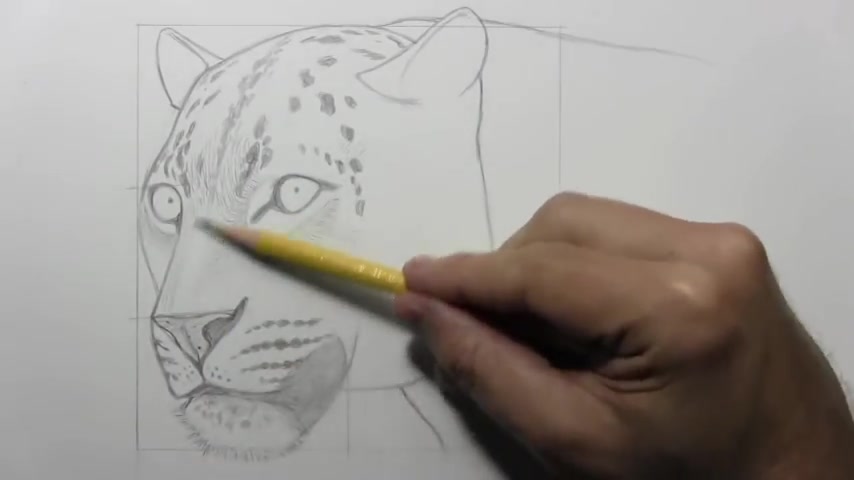
Because there's just , again , no way that I can do all of this uh real time .
But I guess I did notice that um over here uh across the whole area of the snout , I didn't see any spots at all .
So that is a spot free zone and I'm just sort of shading it in uh later on .
I'm gonna pay more attention to the uh like individual hairs and stuff .
But I uh noticed within the photo of at least one uh leopard that I looked at that there was a lighter that the hairs lightened up as they reached uh the actual nose .
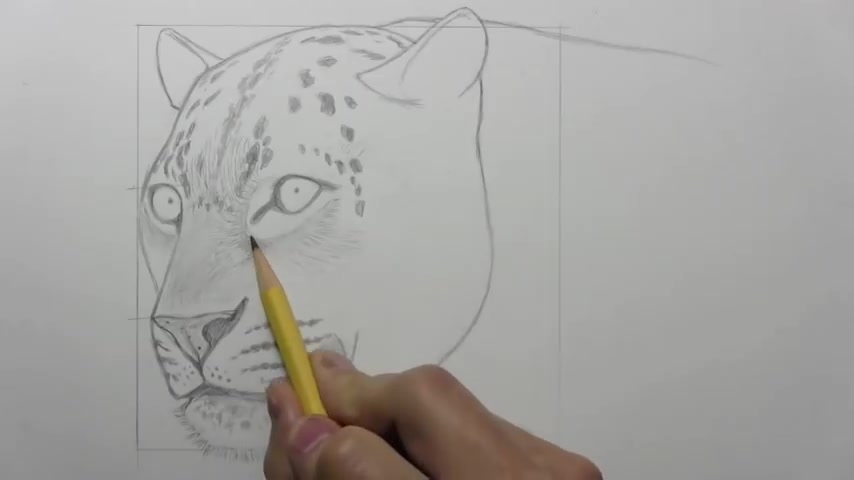
But yeah , this whole area I didn't see maybe a few spots between the eyes but uh no actual spots on the uh snout itself , which I found sort of interesting um some uh photos I saw uh quite a pronounced dark area right here beneath this uh shape of the eye and that can be also kind of helpful for um giving a sense of the , the structure of the snow .
I hope I'm using the right word snout .
Is it a snout ?
I never know the words for .
Um across here , I noticed smaller spots and nearer to the eyes , the spots seem to be smaller , um almost sort of pallet shaped .
Uh and then as you get further and further away , they seem to grow in size and you get larger uh spots over here .
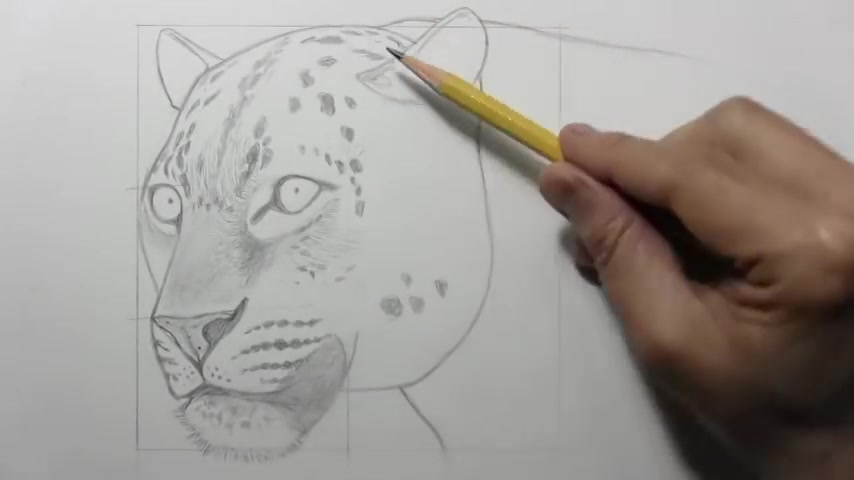
And I , I just , I'm becoming aware , uh more and more aware as I do this video , uh how long it's going , you know , it's taking me so long to , to attempt to teach this stuff real time that I just fear I'm gonna end up with a super long video , uh which can be a little hard for some people to take .
So I think it's time to um maybe do one last thing real time .
Let's focus on the ears .
Um darkening in this area .
I talked about earlier , the the sort of Tufts of hair , let me refocus so you can see this a little closer .
So , yeah , I'm darkening in uh this sort of upper area of the ears , but I did want to sort of point out um about the uh the big Tufts of fur here that really sort of obscure the interior surface , you really can't see very much of the interior .

And so what I'm darkening in here is sort of a suggestion of , uh , this sort of , you know , gap between all the fur that allows you to see into the ear just a little bit .
But I wonder if there's sort of , uh , you know , if having that sort of , uh , is a way of keeping the ears clean , stopping things from going inside insects .
I'm not sure .
Maybe some of , you know , and can explain to me .
Uh , I noticed , uh , in some breeds a dark area here behind the ear and as that comes down , you sort of get back into an area of spots .
And , uh , similarly , as I said before , you're gonna , by having these sort of get narrower side to side , you can help , um , give a sense of the structure of the head and I'm afraid that is probably all I can do real time .
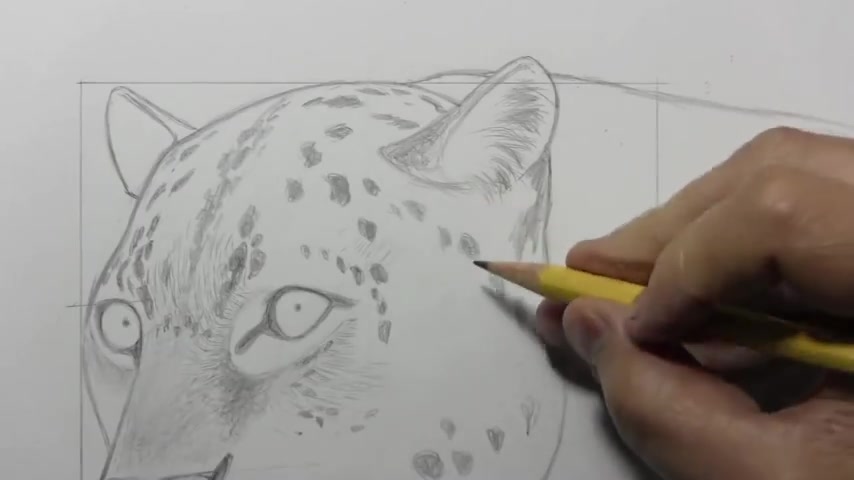
My apologies to those of you who hate time lapse who , who curse old man time lapse and wish that he never came around me .
I'm a big fan of old man time lapse .
He helps me out .
He helps me keep these videos under three hours .
Uh , so I'm gonna go ahead and kick it into time lapse and , uh , finish off , uh , all of the , the , the fur , the spots , all this stuff and maybe come back and do a little more real time , uh , when it comes to adding final line work .
All right .
Well , uh , as you can see uh doing the fur .

If you choose to try to represent the fur , it is kind of an endurance test .
You know , it's a real test of your patience .
And I suppose the one thing I would say is that , um , you know , my approach is to do lots of short , little back and forth movements of my pencil to , uh , try to simulate that really short , uh , fur , which again is something , um , that I noticed in photographs that the , the short fur seemed to extend almost over the , the entire heaven even up onto the back .
You know , it's not a leopard is not an animal with really long Tufts of fur , but rather this very almost , you know , reminds me of like a crew cut or something , you know , military kind of super uh short hair .
Well , it's time for me to pull out my trusty black prisma color .
And uh you know , I just thought I'd do a little bit of this real time .
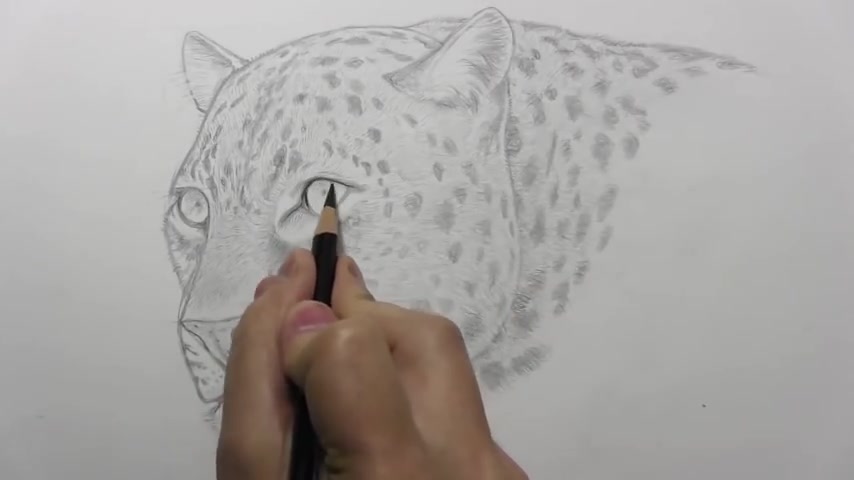
Um Maybe uh let's talk mainly about uh the importance of , of getting contrast uh in almost any um work of art if you have bold blacks and then very bright whites .
Um it improves the look of your illustration .
But I would say with a , a uh an illustration of a uh a leopard that it's particularly crucial to , to have your blacks get really black .
And that's why I'm using this uh really just ordinary black colored pencil .
Um And I , you know , I said again and again , the name of this pencil , it is a Prisma color black PC 9 35 .
It's not a magical special pencil .
It's just a quality uh colored pencil .
So , uh you don't have to go to the Prisma color company if you're in a different country or , you know , you can't get a hold of colors , just make sure you get something that's of some quality and , and it'll provide you uh with a good bold black .
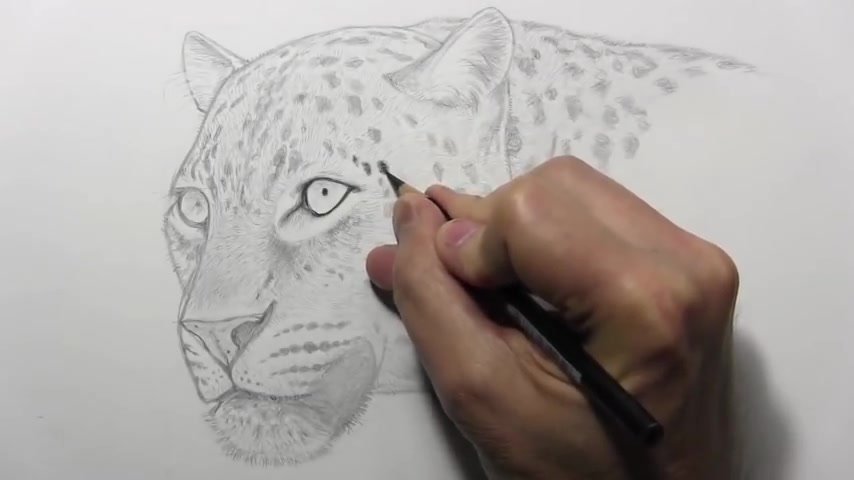
And I think that's really just the key to uh making the illustration pop and seem more three dimensional .
I would say , mainly , um you know , your , your goal is maintaining patience and don't feel that you have to complete the illustration in one sitting .
You can uh take breaks , you can , you know , spread it out over a number of days .
Uh keep coming back to it little by little .
You know , a lot of these people who do photo realism , that's what they're doing .
They're , you know , they're spending weeks on a single painting or whatever they're taking breaks , they're coming back .
So , uh anyway , sadly , I do believe that I am gonna have to once again , kick it back into time lapse , gonna finish up all this uh stuff with the black prisma color and then we'll come back with a little white wash to finish off the illustration .
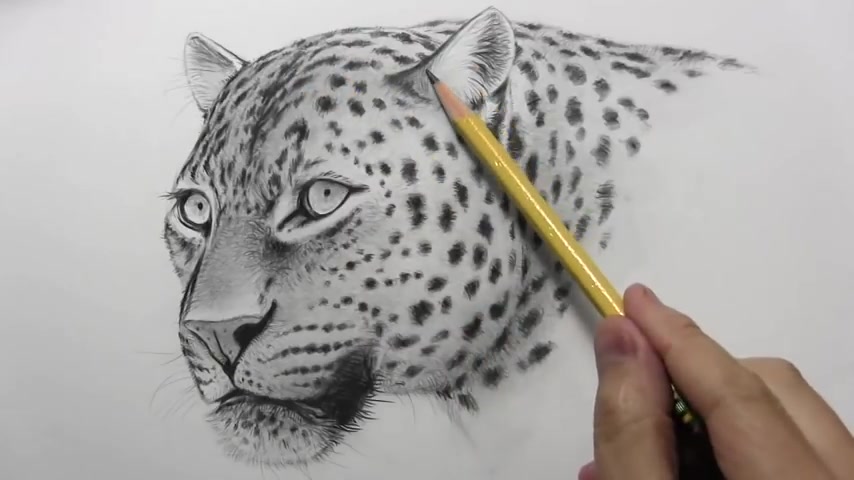
All right .
Well , we're finally uh near the ending stages here , a lot of times people want to know how long did it take me to do uh the illustration .
And , you know , I started this at around eight o'clock this morning .
It's uh 12 noon now .
So about four hours uh that I've put into this illustration .
We're not quite done though because I need to bring out my beloved white gosh .
And I'm going to attempt to add uh whiskers uh down here , in fact , making that very bold black will hopefully allow these , uh to stand out by way of contrast .
Now , it is sort of , um , nerve wracking to try to do this uh with paint because , you know , you only get one go basically .
And if you don't get it quite right , you're a little bit stuck with it .
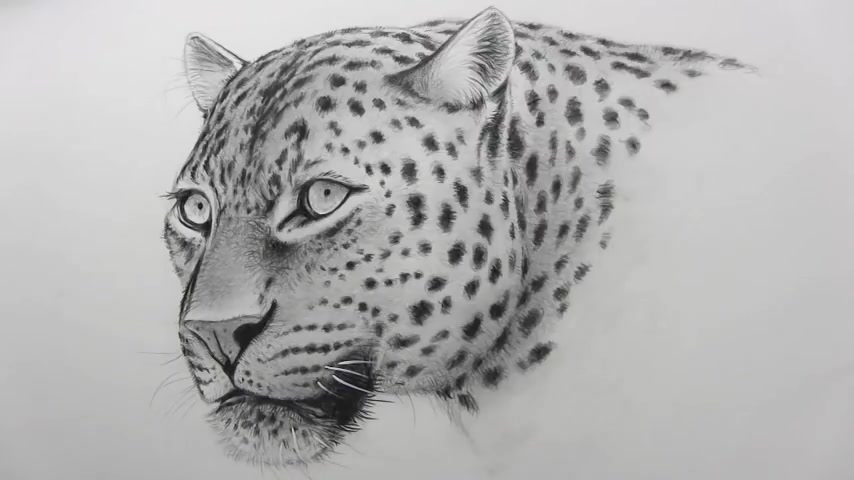
So I'm gonna do a few of these live , but I may sort of allow myself to , uh complete the process , um , in time lapse , but I did want to point out a couple of other uses for the uh whitewash .
Um , get some reflections on the eyes .
I think , uh a bit of uh reflected light there .
We add to the shininess , the sort of glassiness of those eyes don't wanna overdo it .
Uh And then I felt that the uh this area of whiteness near the eyes , uh could be , you know , you could even add to that a little bit and uh suggest uh fur , in fact , uh other areas like near the uh ears as I said quite a lot of uh Tufts of fur or little strands of hair that are becoming visible there .
So you kind of get the basic idea .
Uh really uh sorry that I can't do more of this real time .
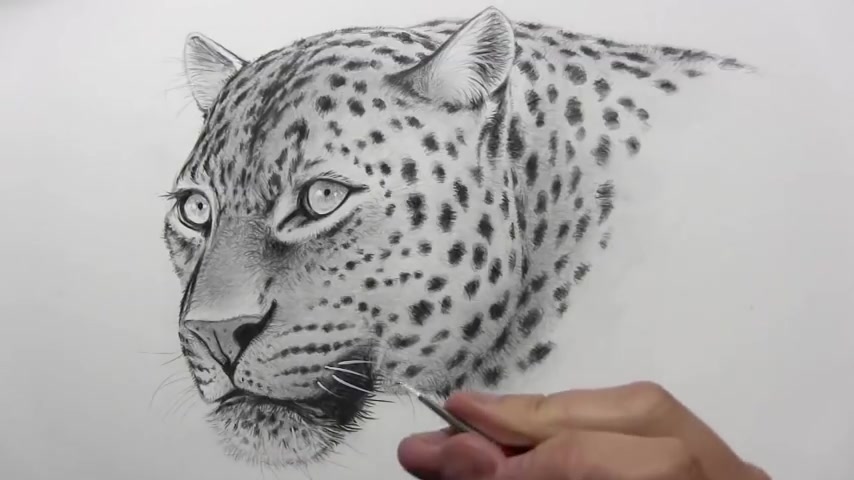
But uh yeah , you know , four hours , what I'm gonna do a four hour video .
You want me to do a four hour video .
Come on people , there are just limits to what can be done uh in terms of uh making videos uh that you know , have a finished illustration of this detailed .
So bear with me .
I'm gonna bring back old man .
Time lapse .
Get in here , man .
Yeah , I'm here .
I'm done with my coffee uh to help me finish off this illustration and then we'll be back with a few final words .
All right .
Well , there's my video on how to draw a leopard .
Let me know what you thought about it .
And also let me know if there are any other animals that you'd like me to draw in future videos .
I'd be happy to do more such videos like this one in the months ahead .

But for now , let me thank anyone who has supported me by getting any of my books like Brodie's Ghost or Meek Falls , my two graphic novel series book six , the final book in the series finally out and available , mastering manga and mastering manga two and now my very newest book , The Realism Challenge .
Big thanks to anyone who uh purchased this book within the last week .
It's been wonderful to see people responding to it positively .
But I think it's time for me to lay down this pencil .
I wanna thank you all for watching this video .
I hope you enjoyed it and I'll be back with another one real soon .
Are you looking for a way to reach a wider audience and get more views on your videos?
Our innovative video to text transcribing service can help you do just that.
We provide accurate transcriptions of your videos along with visual content that will help you attract new viewers and keep them engaged. Plus, our data analytics and ad campaign tools can help you monetize your content and maximize your revenue.
Let's partner up and take your video content to the next level!
Contact us today to learn more.